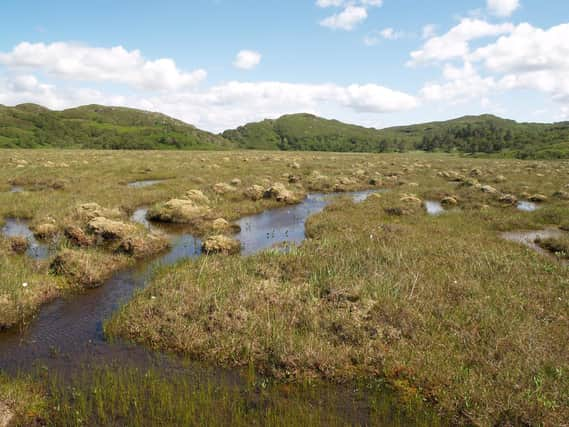Rewilding Scotland: Nature's wins from 2021 and priorities for 2022


Scotland has a global reputation for its rewilding efforts, ranging from sea and land projects to river and community-focused projects.
Rewilding, although definitions vary depending on the organisation, broadly refers to the process of restoring ecosystems to their original, uncultivated state.
Advertisement
Hide AdAdvertisement
Hide AdNot only is this good for the local wildlife and human communities, it also often helps with ecological recovery and helps to reduce the effects of climate change.
In Scotland, with such a diverse range of ecosystems, these projects can look quite different.
With the effects of the climate crisis being seen more and more around the world, with extreme weather, flooding, droughts, and forest fires becoming more common, among other things, rewilding initiatives have never been more important.
Here’s a look back at what has been achieved in 2021 when it comes to rewilding, as well as what’s on the priority list as we move into 2022.
Scottish rewilding wins from 2021
Peter Cairns, Executive Director of Scotland: The Big Picture, a nationwide rewilding charity, looks back on 2021 and highlights two different types of success: symbolic and physical.
It’s vital to have both types of these successes, to continue both the immediate effects of rewilding on Scottish ecosystems and spread awareness of its importance across the country.
Symbolic success for communities
When it comes to symbolism, an important project for Cairns is the sea wilding project in Argyll.
“The significance of it is that it is community-led,” he says. “You've got a group of people come together to effectively rewild the sea loch at Craignish. What it does, of course, is signpost to other communities that they can do similar things.”
Advertisement
Hide AdAdvertisement
Hide AdAnother community-focused success was the land buyout on the Langholm Moors, where the community-led Langholm Initiative successfully bought 5,200 acres of the Langholm Moor and Tarras Valley after financial backing from over 4,000 people.
Seeing projects like this come from the community are vital, not only because it means that people can do something for the land they live on themselves, but also because projects that have the support of the local community are the ones with the most potential to last.
For example, global search engine Ecosia uses the money made from searches via their search engine to fund bio-diversity and tree-planting projects around the world, including several in Scotland this year.
Some of the first questions tree planters ask when starting a project are what the people in the community actually want and need.
“That's not something that you have to start thinking about five to ten years after planting - that's what you have to start with,” notes Pieter Van Midwoud, Chief Tree Planting Officer at Ecosia. “The key factor for the longevity of your project is that the local people believe and drive this project.”
Rewilding wins for Scotland
Of course, symbolism alone isn’t enough to keep Scotland’s natural systems thriving.
Cairns notes that there have been a number of private individuals and companies buying land in order to pursue restorative nature projects.
“Some of them wouldn't necessarily call it rewilding, but, irrespective of what you call it, the emphasis is turning towards nature restoration and recovery,” Peter says.
Advertisement
Hide AdAdvertisement
Hide AdThere has also been a strong focus on river restoration in 2021, which doesn’t only support ecosystems to help species like Atlantic salmon survive, but also help mitigate the effects of climate change.
As one example, the Eddleston Water project received financial support from the Scottish Government, with a focus on restoring the river while reducing the risk and damage from flooding at the same time.
Similarly, the Scottish Government has backed various peatland restoration projects which may have huge potential when it comes to carbon storage.
When it comes to Scotland: The Big Picture themselves, a recent win for the charity was its Northwoods project, which enjoys the collaboration of 35 partners from across the country.
“These are just normal people going about their business, but they want to do something for nature restoration,” Cairns explains. “Across the country, at a very small scale and at a large scale, across diverse settings and with diverse motivations, you've got a whole load of rewilding or major recovery initiatives, either starting out or really gathering momentum.”
Scottish rewilding priorities for 2022
As the year comes to a close, plans are already in motion for rewilding efforts across Scotland in 2022.
For Cairns and Scotland: The Big Picture, they will be picking up on a year-long feasibility study looking at reintroducing crains to the Cairngorms.
Similarly, looking into whether Scotland is ready to reintroduce lynx to the countryside.
Advertisement
Hide AdAdvertisement
Hide AdReintroducing species like these that have died out in their natural habitats is a vital part of rewilding, as it helps to establish a healthy, genetically diverse, self-sustaining population.
You need all the different players of an ecosystem to be able to thrive in order to regain strong biodiversity in the area and for the space to eventually thrive on its own.
More broadly in the rewilding community across Scotland, more and more businesses have begun to take an interest in rewilding or nature restoration projects.
“There is a tension around the business community stepping up and taking responsibility for their carbon stroke, biodiversity footprint,” explains Cairns. “Most people would agree that that's a positive step, but at the opposite end of that extreme, of course, you've got big corporate institutions buying a great chunks of land to effectively greenwash their pollution.
“It'll be interesting to see where that relationship between the business sector and rewilding rolls out over the next few years.”
Comments
Want to join the conversation? Please or to comment on this article.

